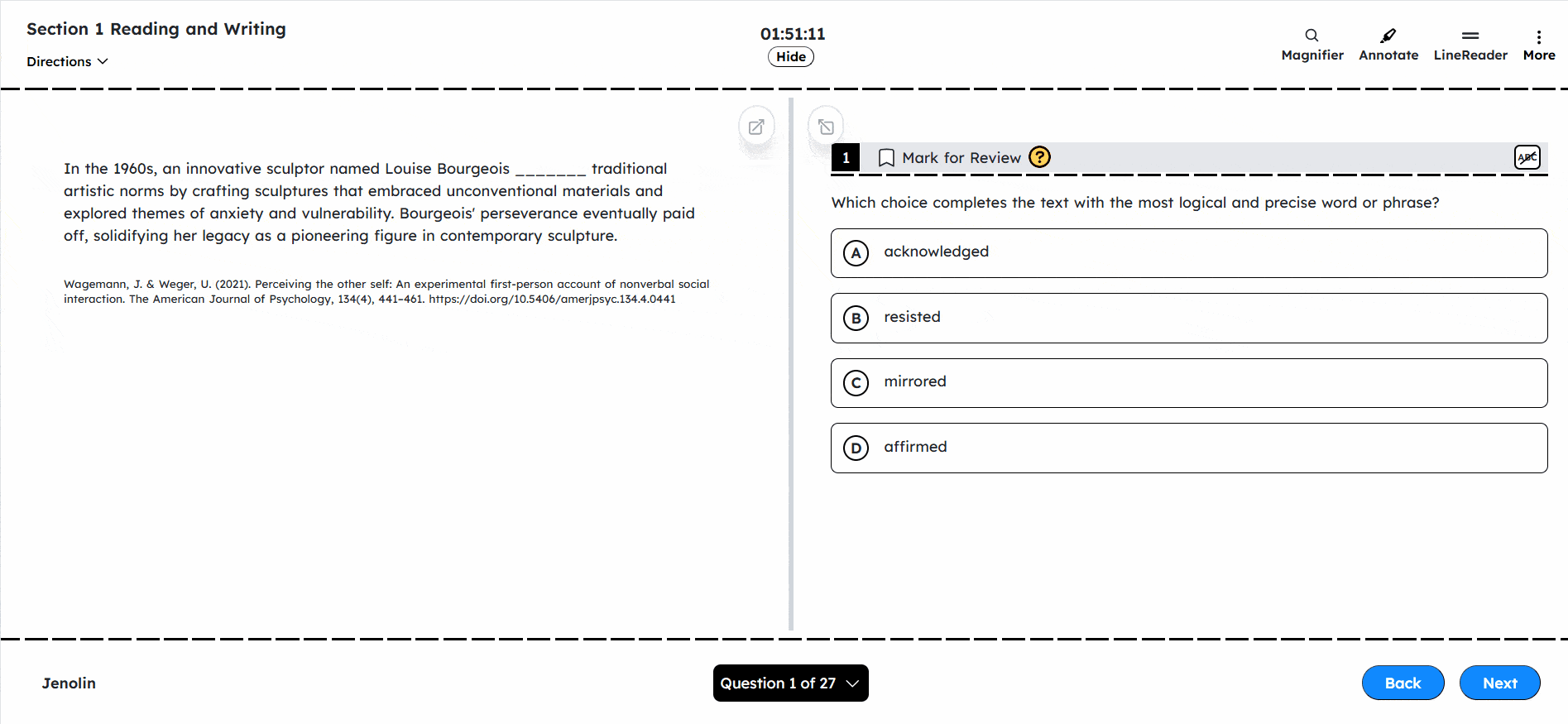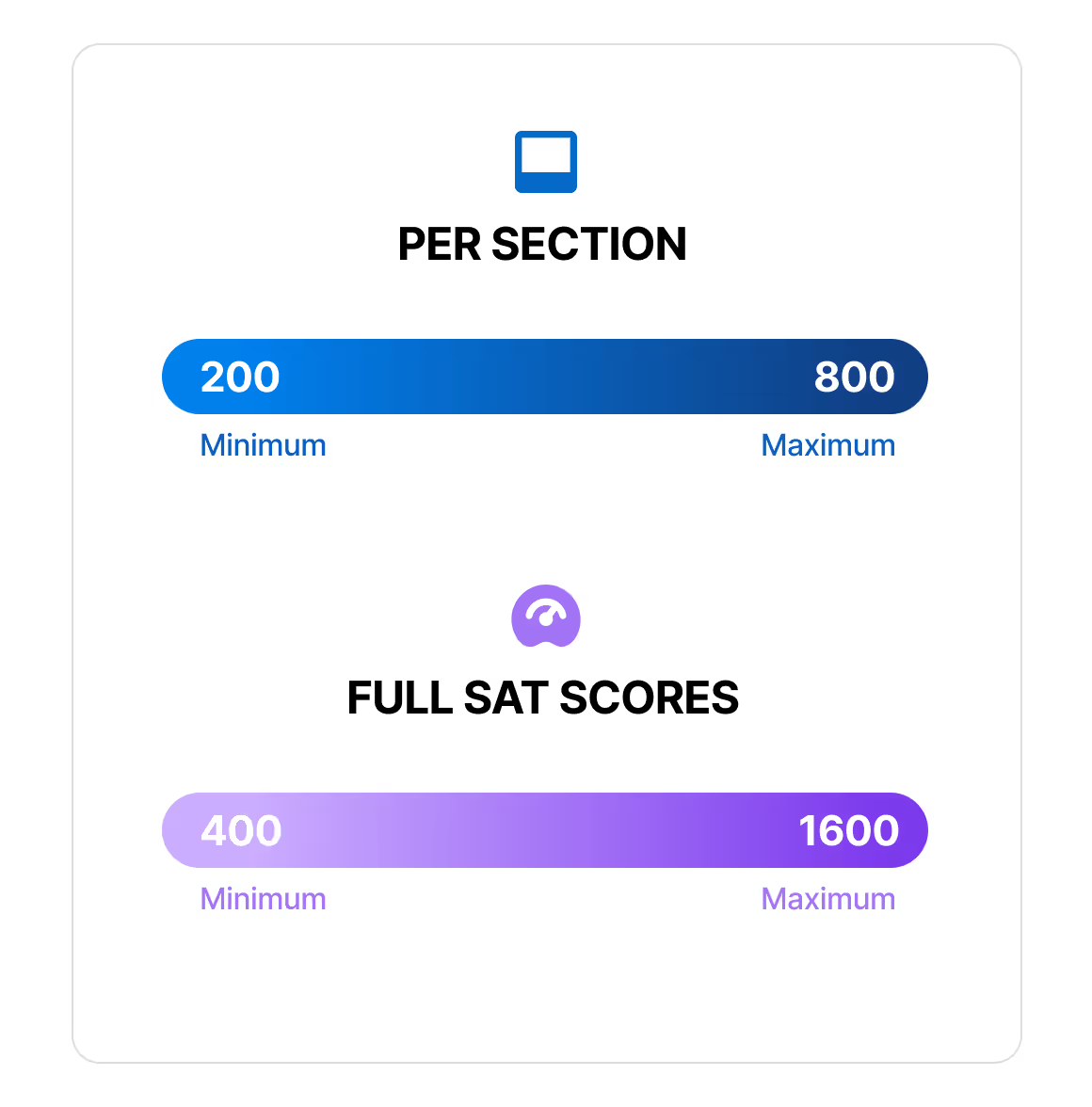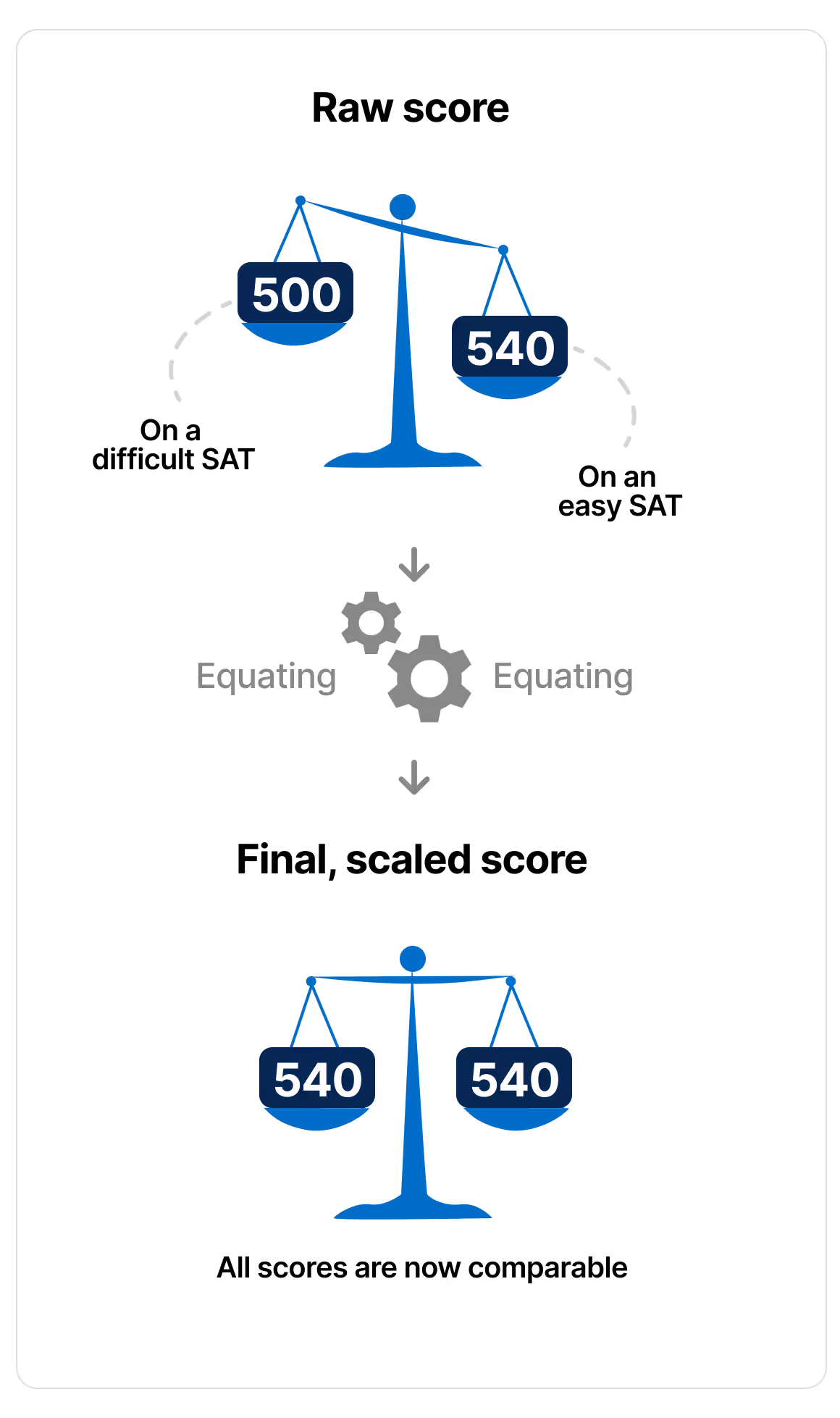




Key Takeaways
- The Digital SAT, which replaced the traditional format in December 2023, has two main sections (Reading & Writing and Math) that adapt based on answers given.
- Scoring is based on both the number of correct answers and the difficulty of questions, meaning students with the same number of correct answers may receive different scores.
- Instead of curving, the SAT uses “equating” to adjust scores based on test difficulty, ensuring fairness across different test versions.
The Digital SAT has replaced the traditional paper-and-pencil SAT from December 3, 2023.
- The switchover is mandatory; the paper-and-pencil format is no longer available.
- Aspirants may take the Digital SAT on a digital device.
- The new format comes with significant changes, including those in scoring, question types, and timings, digital sat curve score calculation, and more.
Read on to learn everything you need to know about the Digital SAT.
It’s not difficult to see why you need to understand the Digital SAT. What colleges you can get into depends greatly on your Digital SAT score. That, in turn, can significantly shape your career growth and your future.
We’ll begin by understanding the format of the Digital SAT. Next, we’ll see what it means when we say a computer adaptive test and how the SAT in digital format is scored. Finally, we’ll talk about grading on a curve and whether the Digital SAT is curved.
The format of the Digital SAT
The Digital SAT, designed and administered by the College Board, comprises two sections: the reading and writing section, and the math section.
Each section is further divided into two modules each. That means there are four modules in the Digital SAT: two under the reading and writing section, and two under the math section. Each module of the reading and writing section carries 27 questions for which you get 32 minutes. This means that the reading and writing section has 54 questions for which the test-takers get 64 minutes.
Against that, each module of the math section carries 22 questions to be answered in 35 minutes each. That way, the math section has a total of 44 questions to be answered in 70 minutes. Further, there will be a 10-minute break between the two sections for the test-takers.
Remember that each of the four modules is separately timed.
The Digital SAT is adaptive - what does that mean?
A simple computer-based test would have a fixed set of questions that appear one after the other. What question comes up next has nothing to do with whether the test-taker answered the earlier questions correctly. That also means the final score is dependent upon the number of questions the student answered. The raw score is the final score and any simple score calculator would do.
An adaptive test is different; it adapts to the performance of the test-taker. What questions you’ll see next depends upon your performance in the earlier questions. In that sense, an adaptive test is dynamic.
When the SAT went from the paper-and-pencil format to the digital format, a lot of things changed. The Digital SAT is adaptive, which means it tailors the subsequent questions based on how the examinee has fared in the earlier questions. Here’s what it means when we say the Digital SAT is adaptive (to be precise, the Digital SAT uses a multistage adaptive design). The test algorithm will serve you questions of moderate difficulty in the first module and rate your performance. If you have done well, the algorithm will serve you questions of higher difficulty in the second module of that section.
On the other hand, if you haven’t performed well, you’ll be given questions of lower difficulty in the second module. The College Board tries hard to make sure that the overall score accurately captures the student’s abilities.
Two key differentiators
Of the many things that make the digital version of the SAT unique, two things stand out.
One, the kind of questions a student will be asked to attempt are not fixed; they depend upon the student’s performance in the previous module.
And two, the Digital SAT scores cannot be estimated using a simple score calculator; getting five easy questions right isn’t the same as getting five difficult questions right. The Digital SAT, being an adaptive test, will take into account the difficulty level of the questions as well as the number of questions answered.
Read on to find out how the SAT algorithm will likely score you.
How does the algorithm for the Digital SAT score you
As we said, the Digital SAT is adaptive, so the questions you’ll see in the second module of each section will depend on how well you did in the first.
Imagine you and your friend Carol taking the test the same day. You do very well in the first module and submit the correct response to 11 questions. So the algorithm gives you more difficult questions, and you get only 10 correct. In all, you got 21 questions correct.
Carol, on the other hand, doesn’t do that well in the first module; she gets 10 questions correct. So the algorithm serves her easier questions, and she gets 11 of them correct. In all, Carol also got 21 questions correct. Notice that while both of you got the same number of questions correct over the two modules, you two will not end up with the same score. Your test scores will be higher because some of the questions you answered correctly were more difficult than the ones Carol did.
Expand this idea to all the other test-takers writing the SAT and you’ll see why many students will land in different score ranges, even if they seem to have got the same number of questions right.
Score ranges of the Digital SAT
The SAT score in each section will fall between 200 and 800. Hence, the total score in SAT digital format will be given out of 1600, with 400 being the lowest and 1600 being the highest.

Arriving at the SAT score in the reading and writing section is a little more complex than it is in the math section because your writing skills need to be boiled down to a number. The SAT score calculator has to take into account all this.
Also, when you prepare for the SAT, remember that the no-calculator questions have been dropped from the math section. Expect more direct questions in this section; the better you understand mathematical concepts, the higher your scores will be. A word of caution: While you are preparing for the SAT, practice tests designed by experts only will help you estimate where you stand; random tests will not be very effective.
What grading on a curve means
In the simplest terms, grading on a curve means the testing authority making changes in the scores. Before we answer whether the Digital SAT is curved, we’ll quickly understand grading a test with a curve.
In a high-school or college scenario, the professor will first grade all the assignments or tests. Once they have all the grades in hand, they’ll see how the entire class has performed. Ideally, the majority of the class scores should be close to the class average, a small minority should be A’s, and a small minority should be at the bottom of the class.
Sometimes this doesn’t happen. The test is so tough that barring two or three students, the entire class does badly, or even flunk. In that case, the professor decides to grade on a curve. That means that they will raise the grades of everyone in the class so that the average of the class also increases. There are various methods by which the professor may raise the grades, but that’s a different story.
Is the SAT curved?
First, a quick answer. No, the SAT is not curved. The SAT curve doesn't exist. We know because the College Board says so.
As an adaptive test, the SAT will rate you based on the number and quality of questions you got right. That means your scores reflect your ability levels. However, since the SAT isn’t graded on a curve, your scores aren’t based on how the rest of the students did.
In the absence of grading on a curve, the next logical thing to understand is the diversity of the SAT questions. Students appearing for the SAT face different questions. Therefore, the tests they appeared for were at different levels of difficulty. A simplistic approach of directly comparing the ‘raw scores’ of two students isn’t fair.
The College Board uses an advanced technique that converts the raw score into a final score that's truly reflective of the student's performance. This technique is called equating.
Equating the SAT scores
So how come the College Board confidently hands out scores of hundreds of thousands of students? How come colleges, year after year, trust the SAT scores for their admission process?
The answer lies in equating. Equating the scores is the process by which each raw score from two different tests is balanced to create a level playing field. Put differently, equating makes sure that the score of an SAT taken yesterday can be reliably compared with one taken some other time. To express it in numbers, equating makes sure that a score of 510 on one SAT reflects the same levels of ability as the score of 510 on the SAT taken a month back.

The College Board can do so by identifying and comparing the difficulty levels of tests conducted on different days. Your raw score of 500 on a difficult version of the SAT might mean the same as the raw score of 540 on an easier version of the SAT. That also means that the impact of three wrong answers in a difficult version could be the same as the impact of just one wrong answer in an easier SAT.
That’s exactly the reason your raw score does not matter for your college admission. The College Board 'equates' or converts your raw scores into final, scaled scores, using an elaborate analysis of the difficulty level of the different versions of the SAT. Colleges use your final scaled scores to arrive at their admission decision.
Why equate the SAT and not grade on a curve
There doesn’t seem to be a full consensus on when to grade a test or assignment on a curve. However, in standardized tests like the Digital SAT, equating the scores is fair to the students and more logical.
When you grade on a curve, the grades you assign to each student depend on how the rest of the class performs. Because the SAT has different test forms, the best thing to do would be to bring parity across difficult and easier versions. When you get a question wrong because the test is difficult, the loss to your score is much lower.
Also, when you grade on a curve, the one or two top scores decide how the rest of the test-takers would be graded. With equating, it’s the difficulty level of the different tests and not the performance of the top scorers, that decides what scaled score will each student receive.
Finally, teachers use curving when they see an unusually high proportion of students who would receive poor scores or might even fail. The SAT isn’t about passing and failing; the section scores reflect your aptitude in that area.
The math modules will show your numerical ability. An educated guess, for example, might give you more points. The writing sections give you a chance to showcase your language skills. If you can balance the reward against the possible penalty, you’ll score better even in a difficult test.
With the Digital SAT, a curve might be a less accurate method of overall assessment than what equating can achieve. After you scale scores from the combined points and then use the equating process, you know the test scores have served their true purpose.
How EdisonOS Empowers Tutors for Digital SAT Success
EdisonOS is a Digital SAT platform designed for tutors to craft high-quality practice tests, simulate the official exam environment, and access powerful student performance analytics.
Overcome the Adaptive Testing Challenge
EdisonOS helps tutors boost student scores by 200+ points with tools built for efficiency, accuracy, and measurable outcomes. The platform addresses the unique challenges of adaptive testing by providing:
Expert-Vetted Content: Access to 5000+ preeminent SAT experts-vetted questions and 22 expert-designed adaptive tests ensures your students practice with material that mirrors the quality and difficulty progression of the actual Digital SAT.
Rapid Test Creation: Build your own practice tests that mimic the real test-taking experience in under 60 minutes, allowing you to customize assessments based on each student's needs and target their weak areas efficiently.
Authentic Test Environment
EdisonOS mimics the Bluebook interface to reduce test anxiety and familiarize students with the real test format, ensuring students are comfortable with the digital tools, calculator features, and interface before test day.
Data-Driven Insights for Better Outcomes
With the Digital SAT's complex scoring system that considers both question difficulty and correctness, tutors need detailed analytics to guide instruction. EdisonOS provides a detailed breakdown of student performance where every second spent is analyzed. This allows you to:
- Identify exactly which question types and difficulty levels challenge each student
- Track progress over time to demonstrate improvement to students and parents
- Create personalized study plans based on concrete performance data
- Understand how students would perform at different difficulty levels in the adaptive modules
Tutor-Centric Design
EdisonOS offers tutor-centric tools to manage multiple students, track progress, and create personalized study plans with ease. Whether you're working with individual students or managing an entire tutoring academy, the platform scales to meet your needs, including white-label options for institutions looking to brand the platform as their own.
Book a demo now.
Frequently asked questions

Tutors Edge by EdisonOS
in our newsletter, curated to help tutors stay ahead!
Tutors Edge by EdisonOS
Get Exclusive test insights and updates in our newsletter, curated to help tutors stay ahead!
Recommended Reads
Recommended Podcasts












.png)
.webp)
